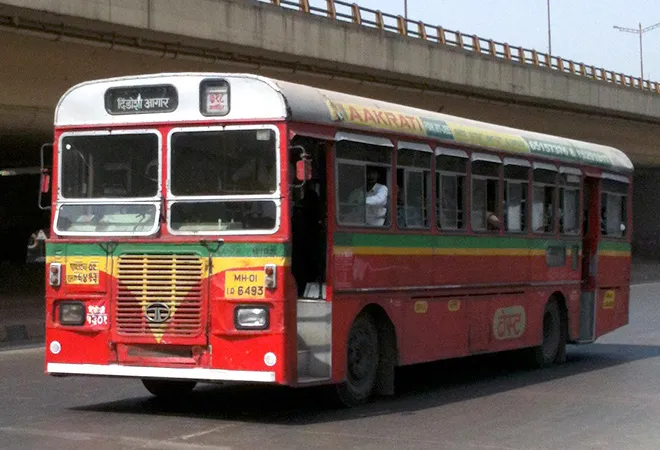-
CENTRES
Progammes & Centres
Location
A slew of reforms announced for Mumbai’s public transport buses can potentially change BEST’s fortunes, but doubts prevail.

After inviting loads of criticism owing to its mounting losses and administrative blunders, the Brihanmumbai Electric Supply and Transport (BEST), Mumbai’s municipal bus service provider, has finally started to attract positive news. The BEST has embarked in mission mode to implement a slew of radical reforms to revive the beleaguered organisation. The announcement of financial assistance to the tune of INR 100 crore per month from the municipal corporation with clear guidelines for its utilisation, the long-awaited plans for route rationalisation, drastic fare reduction, infusion of new buses through the wet leasing route and use of technology are all long-standing reforms that have been carried out in one fell swoop. While each of these reforms are promising, they come with a series of preconditions – which, if not met simultaneously, can potentially defeat their purpose.
Reducing the minimum fare for a commute from Rs 8 for a distance of 2 km to Rs. 5 for travel of up to 5 km is a welcome move. It is in this critical radius of 5 km – particularly from suburban railway stations to offices and homes – that the BEST ridership was seriously dented by shared autos and cabs. Routes between stations and business hubs like Churchgate-Nariman Point, Churchgate-Colaba, Churchgate-Chhatrapati Shivaji Terminus (CST), CST-Colaba, CST-Nariman Point, Bandra station-BKC etc. are high-capacity routes that are currently being served largely by shared autos and cabs, whose fares are regulated by the Mumbai Metropolitan Region Transport Authority (MMRTA). Since the cost of travel is divided amongst four passengers in cabs (three in case of autos) each commuter pays just one-fourth for a shared ride in a cab. Mumbai also has private services such as CityFlo, GoKruze and other local bus operators who operate on many of the underserved BEST routes. The haphazard revision of BEST fares on several earlier occasions had resulted in a mass exodus of commuters who opted for the better and competitively-priced alternatives.
Of the acquisition of 3,000 new buses, 450 will be mini/midi-sized buses which will be easier to navigate through the crowded roads and more economical to operate. These buses will majorly service the critical last-mile connectivity from metro and suburban train stations to commercial and residential hubs. Also, the plan to wet lease these new 3,000 buses will save the asset-heavy organisation from mounting maintenance costs.
The plan to introduce AC buses on the feeder routes at a very competitive rate of INR 6 for the first 5 km- is a drastic reduction from the existing fare of INR 20 for just 2 km of travel. This will surely draw the commuters back to BEST, who had earlier migrated to better AC alternatives available.
All BEST buses will be fitted with electronic indicators to provide information at bus stops as well as on smart mobile devices the estimated time of arrival (ETA) of the buses. With INR 200 crore investment in technology-driven initiatives BEST plans to have 200 bus stop shelters with such live location boards.
Finally, the administration has realised that BEST’s woes aren’t limited to its financial losses. Multiple factors, that lie beyond the control of the BEST, have come to affect the smooth operations of buses leading to a constant and rapid fall in ridership. Growing traffic congestion has severely reduced movement of buses, which today crawl at speeds of not more than nine kmph. Therefore, measures such as strict action against illegal parking on both sides of the roads will help increase the abysmal average speed of BEST buses.
The above reforms may serve as the right medicine for the ailing BEST, but each will have to be carefully executed to get the desired results.
The wet leasing of new buses will require careful planning and clearly spelt-out and measurable deliverables on part of the private partner. Any ambiguity can lead to problems in fixing responsibility and accountability. The Transport For London (TfL) and Seoul city bus transportation models, which have successfully privatised operations offer some good indicators as to how leasing of bus operations have worked for the benefit of the people. Both cities outsourced bus operations and yet have retained the absolute control over monitoring its efficiency and quality of service. In the absence of carefully-planned parameters to fix accountability on the private players, wet leasing will lead to avoidable wrangling.
The plan to give free rides to commuters travelling within 2 km is likely to address the under-capacity utilisation of buses, but is counter-productive. It will be a nightmare for the conductor to keep a tab on who is travelling within the free range and who isn’t. If a ticket is issued to each commuter, it will be at an additional cost incurred by the organisation even on free riders. Delhi government’s recent announcement to give free rides to women in metro trains came under heavy criticism. The Central government which has 50 percent stake in the Delhi Metro Rail Corporation (DMRC) has outrightly rejected this initiative. The minimum fare of INR 5 for rides up to 5 km makes BEST rides extremely competitive against what is currently charged by shared autos and taxis. This alone is likely to provide the magnet for the BEST to reattract its lost ridership to the other transport modes.
The indicators on the bus stops and the app indicating the ETA will work only if they do real-time GPS tracking rather than be based on a static bus timetable. The m-Indicator app, popular among suburban rail commuters, works on a static timetable for BEST buses and the suburban local trains. The advantage with suburban trains’ predictability is that they have the Right to Way, so the static timetable is more or less accurate. Given the absence of right of way for the BEST buses, they will need to be fitted with live GPS tracking devices that can be tracked on a well-designed mobile app to give real-time and precise updates and map-based route selection options. Most developed systems use Artificial Intelligence and software for ‘planning and scheduling’ and/or ‘depot management’ and have smart ticketing systems. The TfL app not only provides commuters with real time bus tracking but also empowers commuters to rate the service and provide their user experience. The BEST will have to become much more tech-friendly to become user-friendly.
The route rationalisation exercise should be undertaken by BEST to identify new routes based on the demographic shifts in the city, which have transformed travel patterns. Route rationalisation is urgently needed to optimally serve new business hubs like BKC, Lower Parel, Andheri etc. It will also need to consider routes that may not be economically viable yet socially justified. Routes such as Kurla Kamani to Sunderbaug (No. 632) etc. should revived through mini/midi buses. Most of these routes serve the poorest of the poor in the city and therefore shouldn’t be abandoned just because they are loss-making.
The effort to curb the illegal parking on both sides of the roads, especially on the arterial routes, is indeed commendable. One of the other key area of improvement which is beyond BEST’s reach but should be pursed, is to enforce Right of Way by allocate dedicated BEST bus lanes in all major and arterial roads. Introduction of new buses and the technology to know ETA of buses will be wasted if the average speed of buses isn’t improved.
The plethora of the decisions made by the administration will help the BEST to get back on its wheels, but any long-term impact will depend on how it manages to walk the thin line between the promise and the equally-possible pitfalls.
The views expressed above belong to the author(s). ORF research and analyses now available on Telegram! Click here to access our curated content — blogs, longforms and interviews.

Paresh Rawal was a consultant with Observer Research Foundation, Mumbai. His current research includes domestic policies on transportation, mobility and logistics. He is working on ...
Read More +